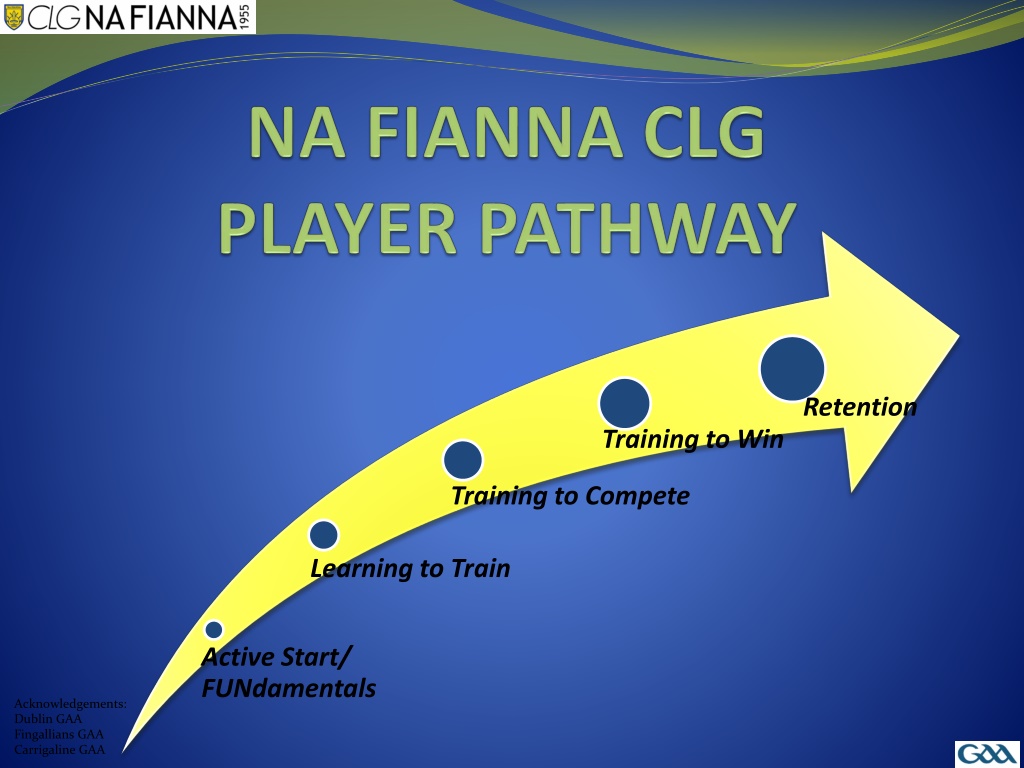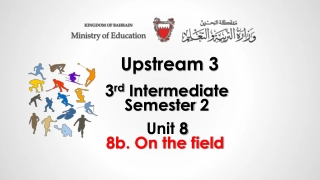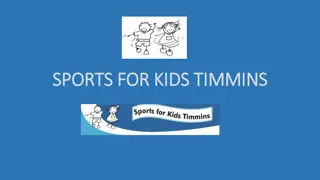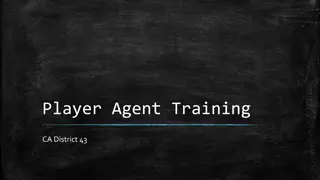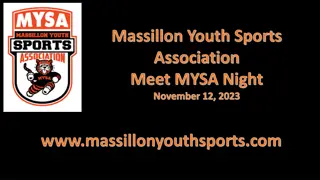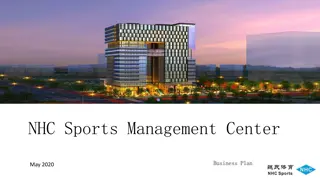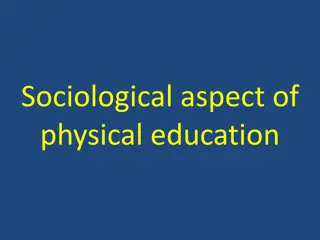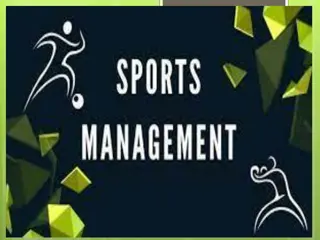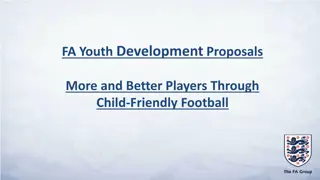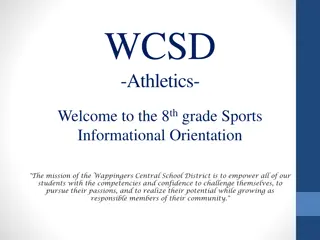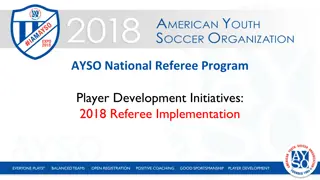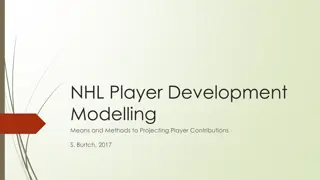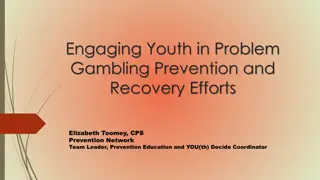Guide to Player Development in Youth Sports
Explore the essential stages in the player pathway, emphasizing skill mastery, teamwork, game strategies, and player development in youth sports. Learn about fun activities, game types, and characteristics of players at different age groups to optimize player growth and performance. Discover the importance of games in enhancing decision-making, problem-solving, and teamwork skills in young athletes.
Download Presentation

Please find below an Image/Link to download the presentation.
The content on the website is provided AS IS for your information and personal use only. It may not be sold, licensed, or shared on other websites without obtaining consent from the author.If you encounter any issues during the download, it is possible that the publisher has removed the file from their server.
You are allowed to download the files provided on this website for personal or commercial use, subject to the condition that they are used lawfully. All files are the property of their respective owners.
The content on the website is provided AS IS for your information and personal use only. It may not be sold, licensed, or shared on other websites without obtaining consent from the author.
E N D
Presentation Transcript
Retention Training to Win Training to Compete Learning to Train Active Start/ FUNdamentals Acknowledgements: Dublin GAA Fingallians GAA Carrigaline GAA
INTRODUCTION There are 5 key stages in the player pathway which have detailed player characteristics and describe the practical elements that must be coached during these ages. The 5 stages are: STAGE AGE EMPHASIS Learning to master the ball 4-6 years Should be about fun and participation with key emphasis on physical literacy and fundamental movement skills with the ball Learning to use the ball well 7-9 years Major skills learning phase where all the basic skills in football & hurling are learned. Emphasis on the fundamental movements. Learning to play together 10-12 years Emphasis on understanding how to play and work together as a team Learning about positions 13-15 years The principles of play and applying good game sense increase Learning to perform 16-18 years Combining all aspects of performance including decision making, higher physical demands of the game and coping with competition It provides a framework for the development of skills, physical focus and game sense that coaches can follow stage by stage. This pathway should not be viewed as a rigid framework but as a guide to optimise player development.
THE FAMILY OF GAMES The reason we play games is to get players to work together as a team and understand what to do, how to do it and when to do it. A game provides increased opportunities for players to make decisions and solve problems. The traditional method of teaching skills and developing players was through drills. The drawback of this approach was that when the skill was learned it then had to be transferred to the game situation. GAME EMPHASIS CHASING GAME These games involve tagging and chasing where players perform skills, such as fleeing and dodging. These games are particularly appropriate for warm up activities TARGET GAMES The simplest form of a game which challenges players to use the technique previously learnt is to aim into or at a target. Players have lots of time to perform the task without any distraction from other players. There is a low level of decision making. COURT GAMES Divided court games require players to pass ball over an obstacle like a net or zone to a receiver. The level of decision making has increased but is limited. The use of other skills essential for team work such as communication, anticipation and spatial awareness become more apparent. FIELD GAMES These are games which require one team to act as the strikers/kickers and the opposition become the fielders retrieving the ball. The fielding team tries to limit the runs or scores by the striking/kicking team and at the same time try to get the opposition players out. Greater decisions have to be made in relation to where, when and how to move or play the ball and good spatial awareness is more important. PART INVASION These games require players to complete a task with limited or direct opposition. Such games encourage awareness of time and space but also help develop characteristics of team play e.g. support play and communication. Part invasion games allow players to develop positional sense and decision making with limited pressure from opposition. FULL INVASION The core objective here is to move into an opponents territory in order to score. To achieve this, players must maintain possession of the ball, create & use space and attack a 'goal. The key element with invasion games is the number of players involved. The less space a player has, the less time he/she has, the more skill is required.
Learning to Master the Ball NURSERY 4 6 YEARS OF AGE PLAYER CHARACTERISTICS Children of this age are self-centred and co-operation is largely absent At this age many still think that the ball is their own toy , so they will try to run with the ball and score rather than pass. They will respond to partner work and skills practice for a short time. This helps introduce they to team work and cooperation. These children will only watch the ball. They cannot and will not look for space to run into. They usually enjoy being asked questions and this should give the coach plenty of opportunities to check for understanding When their team is not in possession they find it difficult to understand defending a goal. To them they are merely chasing a ball They respond best to target games and races (Hitting and throwing, running)
Learning to Master the Ball TA B L E 1 4 - 6 Y E A R O L D S S K I L L E M P H A S I S P H Y S I C A L F O C U S G A M E S P E C I F I C H U R L I N G F O O T B A L L A B C & R J Ts Handling Correct hurley size - Grip (Hurley hand) - Swing-elbow up - Ready, Lock, Lift, Positions - Pick up (Catching hand one hand) Handling - Throw Bowling Ball Two handed Bounce catch One hand bounce - Body Catch - Pick Up stationary & moving Agility e.g chasing games, dodging, e.g shadow running Target Games e.g Skittles Through the gate Tower ball Court Games e.g Over the river Hurling tennis Balance e.g Animal walking e.g Hop in & out of hoops Send & Receiving - One Hand Dribble - Two Handed Dribble - Ground Strike Tyre Ball - Ground Stop - Run Strike stationary Ground ball Part Invasion Getting through the traffic 4v4 (two zones)No Goalie Up North Down South (Ball each scoring) Co-ordination e.g Skipping e.g Bean Bag Toss e.g pass through the ladder Kicking - Ground Kick - Dribble - Punt Kick(Two Hands) (Hard foot) Running Good Technique Forward, Backward, sideward s e.g Marching e.g Stopping Travelling - Knee tap solo Jumping e.g Takeoff & Landing Jump Jacks Throwing e.g Target Roll
Learning to Use the Ball Well 7 9 YEARS OF AGE PLAYER CHARACTERISTICS They will begin to look up when in possession and start choosing options [e.g. passing rather than shooting] They will have difficulty tackling opponents but will kick the ball away from them and attempt to block any shots They have a tendency to stand back in hurling so encourage them to get close to the opponents Use questions to challenge and introduce decision making Players will beg for a game at every opportunity, yet their technique is best improved through individual, paired and small group work. This is an ideal time to use the Whole-Part-Whole approach to some sessions where the coach starts with a game, stops it after ten minutes, works on one technique for a short period then restarts the game Coaches need to focus on positive feedback, this is the age where. drop-outs occur if children think they are no good. At this age players will now try to win the game not only by scoring but also by attempting to deny the opposition the opportunity to score They will also begin to understand the need to change the direction of a run or a pass to be more effective and they will begin to grasp the idea that a player may need support from behind and to the side as well as in front. Coaches should continue to run small-sided games and conditioned games, one of the better games is called Over the River and tennis At this age players must also get used to attacking the ball [i.e. running and not stopping] and breaking tackles First critical period for speed development.
Learning to Use the Ball Well TA B L E 2 7 - 9 Y E A R O L D S S K I L L E M P H A S I S P H Y S I C A L F O C U S G A M E S P E C I F I C H U R L I N G F O O T B A L L A B C & R J Ts Handling - Claw catch - Cupped catch Handling - Body Catch - Low catch - High catch - Fist pass - Hand pass Crouch lift (stationary ball) Agility e.g zig zag relay Target Games e.g Skittles Through the gate Tower ball Balance e.g One leg hopping e.g hop land on other leg Send & Receiving: - Ground striking(a moving ball) Left &Right - Ground doubling (same direction opposite direction) - Striking from the hand (Stationary) Jab lift (Stationary Ball) Court Games e.g Over the river Scout Ball C chulainn Coordination Running - Good Technique e.g On the spot e.g Relay races e.g Hurdle running e.g Stopping Kicking - Punt Kick(Front foot) Left & Right Hook Kick(One Hand) - Pick up-foot Fields Games e.g Rounders Four hitters Part-Invasion e.g 4v4 (zoned) No Goalie e.g line game Jumping e.g leap frog e.g Donkey kicks Travelling - Bean Bag balancing - Ball balancing Travelling - High bounce - Toe tap(stationary) - Soft foot - Roll Full-Invasion e.g 4v4 (two touch) e.g 5v5 (Wide man) Throwing e.g Dodge ball Tackle - Ground Flick (backhand) - Ground clash - Hooking Frontal & ground block (Hurl to Hurl) Conditioning Partner Resistance e.g Tug of war e.g Push & Pull partner e.g The Bridge Whole body exercises Introduce basic Flexibility Tackle - Near hand tackle - Shadowing - Frontal Tackle - Block Down
Learning to Play Together PLAYER CHARACTERISTICS 10-12 Years of Age Players will now compete with greater intensity against each other At this age players will now try to win the game not only by scoring but also by attempting to deny the opposition the opportunity to score They will also begin to understand the need to change the direction of a run or a pass to be more effective and they will begin to grasp the idea that a player may need support from behind and to the side as well as in front. Coaches should continue to run small-sided games and condition them to solve problems During training, these players must always feel part of the session. Coaches must be ready to pay as much attention to them as to other established players and always work to improve their skills [e.g. one-to-one coaching may be needed]. Coaches must be quick to address the problem of one or two players dominating play and preventing others from developing their skills during games. Many players at this age fail to recognise the need to attack the ball and prefer to wait for the ball. If this is allowed to persist, that player will find it increasingly difficult to change his/her instincts. Training needs to be moderately increased at this stage Players are now ready to develop general strength through own body weight and core exercises
Learning to Play Together TA B L E 3 1 0 - 1 2 Y E A R O L D S S K I L L E M P H A S I S P H Y S I C A L F O C U S G A M E S P E C I F I C H U R L I N G F O O T B A L L Handling - Overhead catch (hurl to protect) hand passing (using both hands) Switch pass - Low catch Handling - High Catch - Hand passing (using both hands) Speed - Further development of speed in warm ups (Efforts less than 6 secs) e.g quickness and change of direction and reaction sprints Court Games e.g Over the river Hit the corners Fields Games e.g Crazy kicks Batter bonanza Kicking - Punt Kick left & Right - Punt Kick outside foot Crouch lift moving ball - Toe lift - Hook Kick left & Right Strength - Introduce Core strength e.g twist with partner - Own body strength exercises e.g Pull ups press ups etc . - Introduce plyometric training e.g bounding and hopping Send & Receiving - Striking on the run Short stick left & right - Striking off hurl - First touch control - Jab lift (moving ball) - Roll lift moving ball - Lift & strike - Batting high ball - Side line cuts Part-Invasion e.g 4v1 (Goid) e.g Pass and Attack Full-Invasion e.g 4v4 (Split ends) e.g 5v5 Travelling - Solo Run left & Right - Low bounce - Dummy solo Stamina - Endurance related activities: e.g - Relay running - Small sided games & Ball drills - Circuit training with the ball Flexibility/Co-ordination - Introduction Dynamic Stretching & Mobility exercises - Warm up & Cool down concept Tackle - Near hand tackle - Shadowing - Shouldering - Frontal Tackle - Block Down Travelling - Soloing at speed Tackle - Shouldering - Hooking on the move - Blocking (ground & air) - Doubling in the air
Learning about Positions 13-15 Years of Age PLAYER CHARACTERISTICS While players in this stage my have the same chronically age they may differ significantly in terms of biological age ie one may be more physically developed than another. The onset of puberty usually occurs during the early stages of this cycle. Aerobic and strength programmes should be individualised or grouped according to their (P.H.V )N.B Only trained coaches to undertake this training Broad base skills and sport specific skills Advanced technical skill development Skill developed under pressure Fitness with the ball in skills drills Gain an understanding of the principles of attack and defence through grids and small sided games Players can be introduced to moderate anaerobic and strength training through ball work Players should be introduced to psychological training through games that promote concentration and better decision making
Learning about Positions TA B L E 4 1 3 - 1 5 Y E A R O L D S S K I L L E M P H A S I S P H Y S I C A L F O C U S G A M E S P E C I F I C H U R L I N G F O O T B A L L Part-Invasion Zone games e.g wide man e.g zone to zone Handling - High Catch (protect from front & behind) - Hand Pass off the hurley - Chest Catch Handling - Ball feint - Fist pass for distance - Overhead tap on - Catching at speed High: Reach: Low Half volley Speed - Multi directional (Efforts less than 20 secs) - Quick footwork and agility - Acceleration and deceleration e.g go go stop - Game related reaction exercises - Relay racing e.g crazy ball drills Strength - Body weight Circuit training Upper body ,legs, and back - Develop Core strength e.g plank - Learn correct weight lifting techniques e.g squat, Clean, snatch, N.B Only qualified coaches to undertake this training - Introduce free weights and medicine balls N.B For upper age range group only Plyometric e.g multi directional jumps Stamina - 3 v 1 games - Drills incorporating the ball Flexibility/Co-ordination - Maintain flexibility exercise - Dynamic Warm up Full-Invasion Back v Forwards 15 v 15 Possession Games One rule games e.g Give and Go 4 seconds 2 touch Send & Receiving - Jab lift at pace - Striking on the run (Moving away from the target) - Striking on the run (high & Low) - Doubling Ball in the air - Shooting for scores Kicking - Punt kick to moving target - Long Kick pass - Scoring from angles - Assisted Chip lift - Penalty Kick Travelling - Soloing (changing direction) - Tap & move Travelling - Swerve - Change of pace with the ball Tackle - Frontal block (Hurl to ball) - Low block - Ground tussle - Flick off the hurley (Snig) Tackle - Near hand tackle - Delay opponent &Shadowing - Frontal Tackle - Dive Block - Hand off
Learning to Perform 16-18 Years of Age PLAYER CHARACTERISTICS During this phase players begin to reach their physical peak and those slow developers begin to catch up with their peers Encourage ideals of self-awareness and self-help within players At this stage a Functional Movement Screening (conducted by a physio) should be carried out on each player and the results along with their Critical Success Factors(CSFs) identified by each player in their Self- Assessment Profile should form the basis of their Personal Development Plan (PDP). As a result of the above each player should have a PDP, a component of which should be an individualised conditioning programme developed and delivered by a S&C Coach. Each player should be committed to their programme as they will have had an input into it through their Self-Assessment Profile. Advanced technical skill development Skill developed under pressure Understand the principles of game plays, tactics, and game sense Accept that the team is paramount and their role within the team structure Encourage positive lifestyle and build concepts of team ship and leadership Instill concepts of mental toughness and calmness under pressure(winning behaviours) Encourage flexibility and fine-tune the generic skills to play in a variety of positions Players should be encouraged to embrace positive life-skills i.e. time-management and to take control of their own athletic development.
Learning to Perform TA B L E 5 1 6 - 1 8 Y E A R O L D S S K I L L E M P H A S I S P H Y S I C A L F O C U S G A M E S P E C I F I C H U R L I N G F O O T B A L L Ball Winning - Catching high-low & half volley (protect from front & behind) - First touch off the hurl low, High control - Dribble keep possession Game Plays - How to use a sweeper - How to deal with a sweeper - Man marking - Zone marking Speed (based on test results profile) - Multi directional (Efforts less than 20 secs) - Quick footwork and agility - Planting the foot(the 3 step movement) - Running mechanics & technique - Strength work to improve speed Intense Small-sided (3secs) - Across the line - Total football - Break-Ball & Kick - 4 Goal option 15 A SIDE - Back v Forwards - 15 v 15 Deploying a sweeper Defending the zones Deploying the big man Various Conditions Kicking - Kicking for possession/diagonal ball - Kicking for scores - Cutting in to score - Free kicks/penalties Send & Receiving - Lift & Strike L&R - Strike front foot & Back foot - Feint & Strike - Striking over the shoulder moving away from the target - Overhead doubling and batting - Overhead block the to feet - Over head Flick (direct the ball in your path) Strength (based on test results profile) - FM Assessment to establish core strength and technique - Core programme for those still not ready for weights - Individual programme for those with core strength & good technique - Prefect technique & control N.B Only qualified coaches to undertake this training Stamina (based on test results profile) - Small-sided games - Drills incorporating the ball Ball Retention - Supporting the ball player - Breaking the tackle - Getting out of traffic - Change the direction of play Travelling - Making room(with & without the ball) - Take opponent & protecting the body with the hurl. - Dummy hand pass. Tackle - Near hand tackle - Group tackling - Frontal Tackle - Checking - Blocking ball Flexibility/Co-ordination (based on test results) - Maintain flexibility exercise - Dynamic Warm up Tackle - Shouldering, recover and flick & hook.
